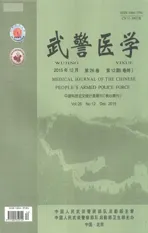应用CTA对无症状非糖尿病高危人群冠状动脉粥样硬化的研究
2015-03-24王耀彬陈天金温友信韩向东陈艳琼
刘 烨,王耀彬,陈天金,温友信,韩向东,陈艳琼,杨 立
应用CTA对无症状非糖尿病高危人群冠状动脉粥样硬化的研究
刘 烨1,王耀彬1,陈天金1,温友信1,韩向东1,陈艳琼1,杨 立2
目的 应用冠状动脉CT血管成像技术(computed tomography angiography,CTA)确定有高危因素,且非糖尿病无冠心病症状者冠状动脉粥样硬化(coronary atherosclerotic, CA)发生率,评价其与高危因素的相关性。方法 在非糖尿病无冠心病症状健康查体的人群中,收集有高危因素(性别、年龄、高血压、高脂血症)者并将其分为单项高危因素组、2项及以上高危因素组。统计有高危因素者冠状动脉粥样硬化发生率。结果 单因素分析发现,年龄和性别对CA的发生率有统计学差异(χ2=4.6,P=0.0032,χ2=6.5,P=0.0108)。高危因素logistic回归分析得出,年龄与CA的发生率有相关性(OR=1.77,CI=1.19~2.66)。高危因素组间比较,多项高危因素CA的发生率有统计学差异(χ2=4.44,P=0.035)。结论 在非糖尿病无症状人群中,CTA能够在一次扫描提供冠状动脉斑块的重要信息,性别、年龄可能对发生CA病变带来更大的风险,作为一项无创性的检查,CTA在CA的诊断中发挥重要作用。
冠状动脉粥样硬化;CT血管成像;危险因素
冠状动脉粥样硬化(coronary atherosclerotic, CA)性疾病的发生发展是一个漫长的过程,无症状动脉粥样硬化常在首次发病就有致死、致残的高风险。在症状出现前的早期病理阶段有效控制致病因素,将延缓或阻止无症状动脉粥样硬化发展成临床心血管疾病。对CA的早期诊断,即尚未引起心肌缺血的临床诊断,无论对于预防冠心病临床事件,还是在高危人群中早期预防性干预治疗,都有重要意义。目前,对我国非糖尿病无症状高危因素人群的CA患者了解甚少。本研究采用双源螺旋CT血管成像方法(computed tomography angiography,CTA),了解有高危因素且非糖尿病无冠心病症状者冠状动脉粥样硬化发生情况,并评价其与高危因素的相关性。
1 对象与方法
1.1 对象 选择2007-01至2010-04于解放军总医院特需住院部查体的40~59岁的非糖尿病无冠心病症状行心脏冠状动脉CTA检查的患者,将年龄≥50岁视为具有年龄风险因素;高血压诊断标准为收缩压≥140 mmHg和(或)舒张压≥90 mmHg,已服用降压药或已诊断高血压病史;高脂血症诊断标准为总胆固醇(total cholesterol, TC)≥5.2 mmol/L和(或)三酰甘油(triglyceride, TG)≥1.7 mmol/L,已服用降脂药或已诊断高脂血症病史[1]。按风险因素,分别分为单项因素组与多项因素组。临床数据可用者,均记录血压、血脂。受检者均为自愿并签署知情同意书。排除标准:(1)继发性高血压;(2)患有可能导致血脂异常的疾患:如糖尿病、慢性肾病、胰腺炎,以及其他慢性疾患;(3)不接受/耐受MDCT、CAG检查者,如碘过敏、心律不齐、β受体阻滞药禁忌证等;(4)受试者自愿中断试验。
1.2 方法
1.2.1 仪器设备及扫描方法 采用SIEMENS SOMATOM Definition双源CT扫描机,扫描参数:管电压120 kV,管电流380~400 mA,层厚为0.6 mm,螺距0.2~0.4。扫描前舌下喷硝酸甘油气雾剂约1 mg。常规行钙化积分扫描,范围自气管隆突下1 cm处至膈面下2 cm。扫描前采用触发团注模式,兴趣区设在主动脉根部平面,触发阈值为100 Hu;对比剂选用碘普罗胺(370 mg/ml),注射总量70~85 ml,注射速率4.5~5.5 ml/s,随后以5 ml/s注射50 ml生理盐水。受检者扫描时须屏气8~12 s。原始数据重组成多时相横轴位影像,传输至“Syngo aquisition workplace”工作站,采用容积再现(VR)、最大密度投影(MIP)、多平面重建(MPR) 进行后处理。如患者心率波动≤5次/min,采用机器自动设置的螺距进行扫描;患者心率波动6~10次/min,则以(患者最低心率~10次/min)为基准选用相应的螺距进行扫描;患者心率波动>10次/min,则以(患者最低心率~20次/min)为基准选用相应的螺距进行扫描。
1.2.2 图像分析 在完成冠状动脉血管重建后,由2名具有5年以上心血管影像诊断经验的放射科医师对图像进行分析,分析图像质量并判断有无动脉粥样硬化有无及程度。图像分析分别按以下3个层面为计数单位,即受试者个体三主支,即右冠状动脉、左冠状动脉(包括左主干)和回旋支;根据AHA节段改良的10段分法[2]。冠状动脉粥样硬化的判断,两个观察者如意见不同则协商后统一或征求第3位专家。
1.3 统计学处理 采用统计分析软件STATA 13.0,采用频数(百分比)描述不同人群CA发生情况,组间比较采用χ2检验。以是否发现CA作为应变量,年龄、性别、高血压等高危因素作为自变量,采用逐步回归法进行多重logistic回归分析(以作为显著性水准),考察无症状人群中冠状动脉粥样硬化与高危因素的关系。按性别分层分析,将年龄、高血压、高脂血症高危因素组合,比较含1个或≥2个高危因素人群组间发生率的差异。P<0.05为差异有统计学意义。
2 结 果
符合标准者427例,有CA者266例,发生率为62.3%,没有CA者161例。单因素分析发现,年龄和性别对CA的发生率有统计学差异,高血压及高血脂无统计学差异(表1)。高危因素logistic回归分析得出,年龄与CA的发生率有相关性(表2)。含有单项高危因素的共有275例,其中检出CA157例,发生率57.09%;含有多项高危因素的共计162例,检出CA109例,发生率67.28%;多项高危因素CA发生率较单项高危因素高,差异有统计学意义(χ2=4.4469,P=0.035)。

表1 无症状非糖尿病人群中CA与性别、年龄及高危因素的相关性 (n;%)

表2 无症状非糖尿病人群中CA高危因素logistic回归分析
3 讨 论
随着64排以上MDCT(multi-detector computed tomography)广泛应用于冠状动脉成像,其在评价管腔狭窄、发现斑块、判断斑块性质方面的能力逐步得以肯定。根据对28项CTA与传统血管造影对照研究的荟萃分析[3]得出,CTA诊断CA的敏感度达99%,特异度为89%,阳性预测值93%,阴性预测值100%,具有极高的准确性。
最近的一项研究表明,CTA为那些超过临床危险因素基线、且已知或可疑冠状动脉疾病(coronary artery disease,CAD)的患者提供了独立的预后信息[4-7]。根据统计结果,本组人群中CTA发现CA者占总人数62.3%。在以往采用CTA对无症状人群的研究中,粥样硬化的检出率为22%~71%[8-11]。各研究之间数据变异程度较大,这可能是由于抽样误差以及受检人群人种、风险因素暴露情况、抽样方式等差异造成的。尽管本研究所有受检者并非来自社区人群,但在除外糖尿病人群后,CA的比例依然较大,提示临床不应放松对无症状人群的关注,并应对CA早期诊断给予足够的重视。在相同的年龄及相同数量的危险因素情况下,男性比女性多4倍出现CAD。这一发现可能是因为在这一年龄组[平均(54+7)岁]的女性有这种疾病的概率比男性低。在男性几乎有1/6的冠脉事件是出现在55岁之前。在至少有3个危险因素的女性,到55岁以后绝对冠脉危险仅超过10%[12]。
一系列环境、基因及内生性因素都对早期冠状动脉粥样硬化的发生产生作用,而其中性别、年龄、高血压、高血脂及吸烟被公认为是冠心病的传统风险因素[13]。本研究中,各风险因素组CT发现粥样硬化比例分别为男性65.73%、年龄高风险66.41%、高血压59.13%、高血脂59.91%。在单因素分析中,年龄和性别对CA的发生率较高,高血压及高血脂无统计学差异。而多因素分析中,多项高危因素CA的发生率与单项高危因素CA的发生率有显著性差异。高危因素logistic回归分析得出,性别年龄与CA的发生率有相关性。这可能反映出各风险因素在无症状非糖尿病人群中冠状动脉粥样硬化各发展阶段的作用程度不同,性别、年龄可能对发生CTA可识别CA病变带来更大风险。虽然在本次研究中,高血压和高脂血症对CA的发生没有显著差异,但仍不能掉以轻心。
本研究与Framingham等[14]的研究有较好的相关性,均表明CA危险性的增加与危险因素聚集性程度呈阶梯式上升。然而,临床冠状动脉CT用于筛查军队人员的试验过程中发现,单一的阳性结果不是改变并降低冠状动脉危险因素的积极有效的力量[15]。筛查的主要目的是确定患者,并可能通过药物治疗或心肌血管重建术改善患者的预后。
在无症状非糖尿病人群,CTA能够在一次扫描提供CA的重要信息,性别、年龄可能对发生CTA可识别的CA病变带来更大风险,作为一项无创性的检查,CTA在CA的诊断中发挥重要作用。
[1] 陈灏珠, 林果为. 实用内科学[M]. 13版.北京:人民卫生出版社,2009:182.
[2] Vasan R S, Sullivan L M, Wilson P W,etal. Relative importance of borderline and elevated level of coronary heart disease risk factors[J]. Ann Intern Med, 2005, 142(6): 393-402.
[3] Mowatt G, Cook J A, Hillis G S,etal. 64-slice computed tomography angiography in the diagnosis and assessment of coronary artery disease: systematic review and meta-analysis[J]. Heart, 2008, 94(11): 1386-1393.
[4] Pundziute G, Schuijf J D, Jukema J W,etal. Prognostic value of multislice computed tomography coronary angiography in patients with known or suspected coronary artery disease[J]. Am Coll Cardiol, 2007, 49(11): 62-70.
[5] Min J K, Shaw L J, Devereux R B,etal. Prognostic value of multidetector coronary computed tomographic angiography for prediction of all cause mortality [J]. Am Coll Cardiol, 2007, 50(11): 1161-1170.
[6] Carrigan T P, Nair D, Schoenhagen P,etal. Prognostic utility of 64-slice computed tomography in patients with suspected but no documented coronary artery disease [J]. Eur Heart J, 2009, 30(3): 362-371.
[7] Aldeman E L, Corley S D, Fisher L D,etal. Five-year angiographic follow up of factors associated with progression of coronary artery disease in the Coronary Artery Surgery Study (CASS). CASS Participating Investigations and Staff [J]. Am Coll Cadiol, 1993, 22(4): 1141-1154.
[8] Hwang Y, Kim Y, Chung I M,etal. Coronary heart disease risk assessment and characterization of coronary artery disease using coronary ct angiography: comparison of asymptomatic and symptomatic groups[J]. Clin Radiol, 2010, 65(8): 601-608.
[9] Iwasaki K, Matsumoto T, Aono H,etal. Prevalence of subclinical atherosclerosis in asymptomatic patients with low-to-intermediate risk by 64-slice computed tomography[J]. Coron Artery Dis, 2011, 22(1): 18-25.
[10] Lee B C, Lee W J, Hsu H C,etal. Using clinical cardiovascular risk scores to predict coronary artery plaque severity and stenosis detected by ct coronary angiography in asymptomatic Chinese subjects[J] . Int Cardiovasc Imaging, 2011, 27(5): 669-678.
[11] Choi E K, ChoiS R, Rivera J J,etal. Coronary computed tomography angiography as a screening tool for the detection of occult coronary artery disease in asymptomatic individuals [J]. Am Coll Cardiol, 2008, 52(5):357-365.
[12] Ghassan Z, Yehudai D, Rosenschein U,etal. Coronary artery disease in an asymptomatic population undergoing a multidetector computed tomography (MDCT) coronary angiography [J]. Open Cardiov Med J, 2010, 4(4): 7-13.
[13] National Cholesterol Education Program (NCEP) Expert Panel on Detection, Evaluation, and Treatment of High Blood Cholesterol in Adults (Adult Treatment Panel Ⅲ). Third report of the National Cholesterol Education Program (NCEP) Expert Panel on Detection, Evaluation, and Treatment of High Blood Cholesterol in Adults (Adult Treatment Panel Ⅲ) final report [J]. Circulation, 2002, 106(25): 3143-3421.
[14] Kannel W B. Risk stratification in hypertension: new insights from the Framingham study [J]. Am J Hypertens, 2000, 13(11): 3S-10S.
[15] Murabito J M, Evans J C, Larson M G,etal. Prognosis after the onset of coronary heart disease: an investigation of differences in outcome between the sexes according to initial coronary disease presentation [J]. Circulation, 1993, 88(6): 2548-2555.
(2015-06-12收稿 2015-10-20修回)
(责任编辑 武建虎)
A study of computed tomography angiography (CTA) on coronary atherosclerosis in risk factors asymptomatic population
LIU Ye1, WANG Yaobin1, CHEN Tianjin1, WEN Youxin1, HAN Xiangdong1, CHEN Yanqiong1,and YANG Li2.
1. Radiology Department, 2nd Hospital of Beijing Municipal Corps, Chinese People’s Armed Police Force, Beijing 100037, China; 2. Radiology Department, General Hospital of PLA, Beijing 100853, China
Objective To make use of coronary CTA to determine the incidence rate of coronary atherosclerosis for non-diabetic asymptomatic people who have risk factors and evaluate its correlation with risk factors. Methods We recruited non-diabetic asymptomatic people who had high-risk factors (sex, age, hypertension, hyperlipidaemia) and divided them into single high-risk factor group and multiple high-risk factors group. Statistics was conducted on the incidence rate of disease for people who had high-risk factors in coronary atherosclerosis. Results Single risk factor grouping analysis showed that gender and age had significant difference in the incidence of CA(χ2=4.6,P=0.0032,χ2=6.5,P=0.0108) . For risk factors between groups, the incidence of multiple risk factors CA had significant difference (χ2=4.6,P=0.0032,χ2=6.5,P=0.0108). Logistic regression analysis showed that risk factors correlated with age and incidence of CA (OR=1.77,CI=1.19-2.66). Conclusions In asymptomatic non-diabetic population, CTA provides important information about coronary plaque in one scan, gender and age may have a greater risk of CA disease. As a non - invasive examination, CTA plays an important role in the diagnosis of CA.
coronary atherosclerosis; CTA; risk factors
刘 烨,硕士,主治医师,E-mail: Minnie_lmm@sina.com
1.100037,武警北京总队第二医院放射科;2.100853 北京,解放军总医院放射科
杨 立,E-mail:yangli301@yahoo.com
R543
